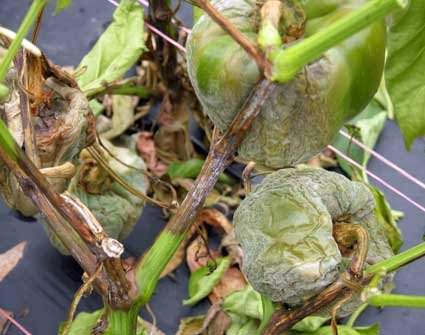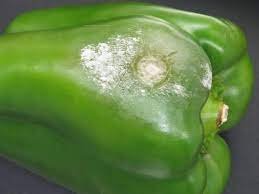Table of contents of the article
Toggle
Phytophthora blight is a serious fungal disease that affects pepper plants, causing rapid wilting and death of the plant. This article from the “WORLD OF PLANTS” website provides information about the causes of Phytophthora blight on pepper and methods of effective prevention and control.
Causes of Phytophthora blight on pepper
- Disease name: Phytophthora blight on pepper
- Scientific name: Phytophthora capsici
- Type of disease: fungal
- Disease family: Peronosporaceae
Phytophthora blight is caused by the fungal pathogen Phytophthora capsici. The pathogen overwinters in the soil forming oospores of the fungus, survival structures that can persist for more than 10 years.
Symptoms of Phytophthora blight on pepper
The fungus shows a wide range of symptoms depending on the specific part of the plant affected and the stage of the crop. Symptoms usually appear first at the soil line in the roots and crown. The fungus is a soil-borne pathogen. The most common symptoms on peppers are crown rot and fruit rot, which becomes Eventually covered with white to cottony mold.
Development cycle of Phytophthora blight on pepper
The fungus spreads quickly through water and can contaminate irrigation ponds and streams, as infection can occur on any part of the plant under the right conditions.
Suitable conditions for the spread of Phytophthora blight on pepper
Pepper fruits can become infected when rain falls or by overhead irrigation on infested soil, under humid conditions and warm temperatures of 20 to 30°C.

Losses resulting from the spread of Phytophthora blight on pepper
As the infection progresses, the fungus on the crown turns into dark brown to black spots that extend upward to encircle the trunk. The roots also appear to wilt, causing the plant to die, which leads to significant crop losses.
Control of Phytophthora blight on pepper
- Avoid using surface water such as ponds for irrigation as it may be infested.
- Remove infected pepper fruits or diseased plants and dispose of them away from the field.
- Drip irrigation application provides protection against fungus and avoids overhead irrigation.
- Use fungicides such as mefenoxam in irrigation water or spray it to limit the spread of the fungus.
Preventive measures for Phytophthora blight on pepper
- Cultivation of disease-resistant varieties.
- Plant in a field that has good drainage and even terrain that does not promote standing water for long periods of time.
- Sterilize agricultural equipment before and after use to avoid spreading the fungus.
- Good fertilization helps the plant resist disease.
- Field monitoring for early detection of the disease.
In conclusion, we would like to note that we, at the world of plants website, offer you all the necessary services in the world of plants, we provide all farmers and those interested in plants with three main services::-
- Artificial intelligence consulting service to help you identify diseases that affect plants and how to deal with them.
- Blog about plants, plant diseases and care of various crops ... You are currently browsing one of her articles right now.
- An application that provides agricultural consultations to clients, as well as a service for imaging diseases and knowing their treatment for free – Click to download the Android version from Google Play Store، Click to download the IOS version from the Apple App Store.




